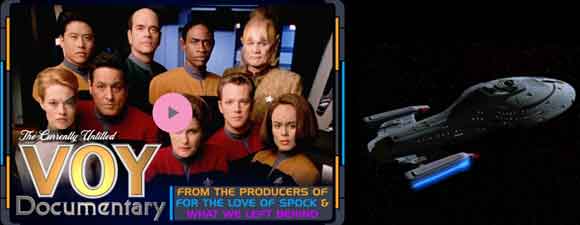Retro Review: Real Life
5 min read
reallifebanner
The Doctor creates a holographic family so that he can share the experience of having one with his patients.
Plot Summary: While Voyager tries to find out what happened to a space station inhabited by friendly scientists, the Doctor programs a holographic family for himself so that he can better understand humanoid behavior. But when Torres and Kes meet the idealized 1950s wife and perfectly behaved children at a programmed dinner, they point out that the Doctor’s family is entirely unrealistic and claim he’d learn much more if Torres altered the program’s parameters to make the wife and children less predictable. The Doctor then returns “home” to find that his wife, a former homemaker, now has an important job with unpredictable hours, so she expects him to do some of the cooking. His son is hanging out with aggressive Klingons, and his daughter has become a competitive player of parisses squares. Nobody treats the Doctor like the benevolent patriarch he perceives himself to be, and his wife resents how little he solicits her input on their family life. As Voyager tries to collect plasma from the storm-like anomaly that destroyed the space station, the eddies engulf the shuttlecraft piloted by Paris to carry out the mission. The ship escapes safely, but the Doctor’s daughter is injured playing parisses squares and the Doctor is unable to save her life. He shuts down the program, but a recovering Paris convinces him that he should learn why family is really important by experiencing how major losses like the ones suffered by other Voyager crewmembers can allow for mutual comfort and bonding. The Doctor returns to his program, where his grieving wife and son come together with him over the dying girl.
Analysis: I know many people find “Real Life” moving, and that’s fair. Robert Picardo gives an emotional performance, Paris and Torres do some flirting, Janeway makes defensible command decisions, and that’s enough to keep me from calling this a terrible episode. But it’s still one of my least favorites in a season that has several other contenders. I should probably confess that I hate feeling manipulated by melodrama, which is thankfully rare on Star Trek. I’m as capable as the next person of bursting into tears while Kira describes the horrors of the Occupation in “Duet” or while Picard faces the death of a planet in “The Inner Light,” but I snicker over the final minutes of the Oscar-winning Terms of Endearment during the over-the-top death scene, and I roll my eyes during the unnecessary denouement of The Notebook when it sacrifices the chance to end on a realistic note in favor of unrealistic tripe. I’m not sure who thought Voyager needed a dose of domestic drama in the first place, but making it holographic – and suggesting that the Doctor’s ideal woman is a Stepford Wife – undercuts its emotional value. I’d much rather have seen why Torres decided to braid her hair and read romance novels, because although I certainly have no objections to women doing either of those things, the abruptness of this change makes it appear less like character development and more like a stereotypical signal of her softening up for Paris – underneath that tough exterior lies a real girl! Maybe that will save her from the ugly anti-Klingon bigotry we see in the fantasy life of the Doctor, here ironically named Kenneth after series producer Ken Biller.
We know well that the Star Trek franchise is backward about gender and sexuality – it has taken until the day I’m writing this in 2016 to learn that in the reboot movie franchise, we will finally have a gay character in canon – but the Doctor’s dream family is still painful to see. He’s on a ship with a female captain, a single mother who’s raising a child half a galaxy away from her husband, a male engineer who defied Starfleet orders to get home to his kids…how in heck did Doc develop the idea that a “normal” family consists of a stay-at-home mom who hangs on her husband’s every word and two children in need of a smug masculine head of household? Even after Torres reprograms them to cause him some typical family angst, they’re portrayed as needing a condescending father figure, since it turns out he’s right about everything – trying to become a Klingon will only bring his son unhappiness and playing parisses squares will get his daughter killed. Of course she dies beautifully, as women and children usually do on celluloid – no agonizing headaches, no vomiting, no aphasia, no confusion, no frantic terror, just a bit of sweet weepiness and a single band-aid to imply the terrible clotting and hemorrhaging that’s destroying her brain – but she’s uninteresting and unconvincing, an outline of a child rather than a character, so the idea that we’re supposed to weep for her is preposterous. The Doctor’s grief that he’s not programmed with enough skill to save her virtual life seems a point of greater distress for him than her holographic suffering. It’s the grief of someone who’s become a bit over-involved in a movie or a book – it can easily be fixed in the sequel program, and in Star Trek often is, whether it’s Spock’s death in a film or Janeway’s in two episodes this season.
Let’s put aside practical matters like how a ship with depleted energy reserves can keep the holodeck running so that the holographic doctor can have a holographic emotional experience – I guess nobody remembers “The Darkling” – not to mention the need for Starfleet to develop a shuttle that can be operated remotely to keep crewmembers safe. There’s a serious waste of resources going on with this show’s characters. Star Trek writers have frequently eschewed intimate relationships in favor of aliens of the week and tragic loves, but Voyager‘s writers apparently see no irony that the person who most wishes to explore a “real” life is the artificial one, and that in giving the Doctor what everyone tells him is the most important of all human bonds, the nuclear family, they’re highlighting the superficiality with which all the other characters’ private lives have been treated. The Doctor spends more time grieving a fictional daughter he knew for – what, a couple of weeks? A month? – than we’ve seen just about any other crewmember grieve over a lost Earth family or a death in the Voyager “family” that Paris cites. The episodes from which “Real Life” swipes its plot, The Next Generation‘s devastating “The Offspring” (in which Data creates an android child) and quirky “Ship in a Bottle” (in which Picard accepts the reality of holographic feelings), have real world implications about parental and authorial rights and responsibilities, the limits of technology, the way fictional people can matter to us in much the same way as real ones. “Real Life” offers little beyond a solid performance by Picardo and a cool space storm.






